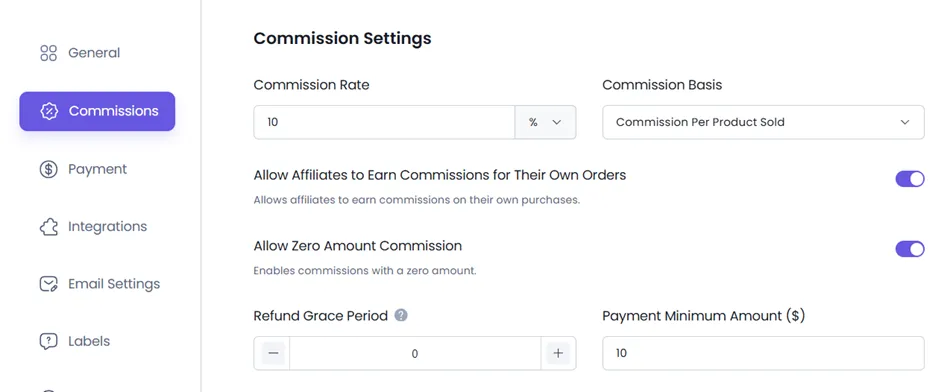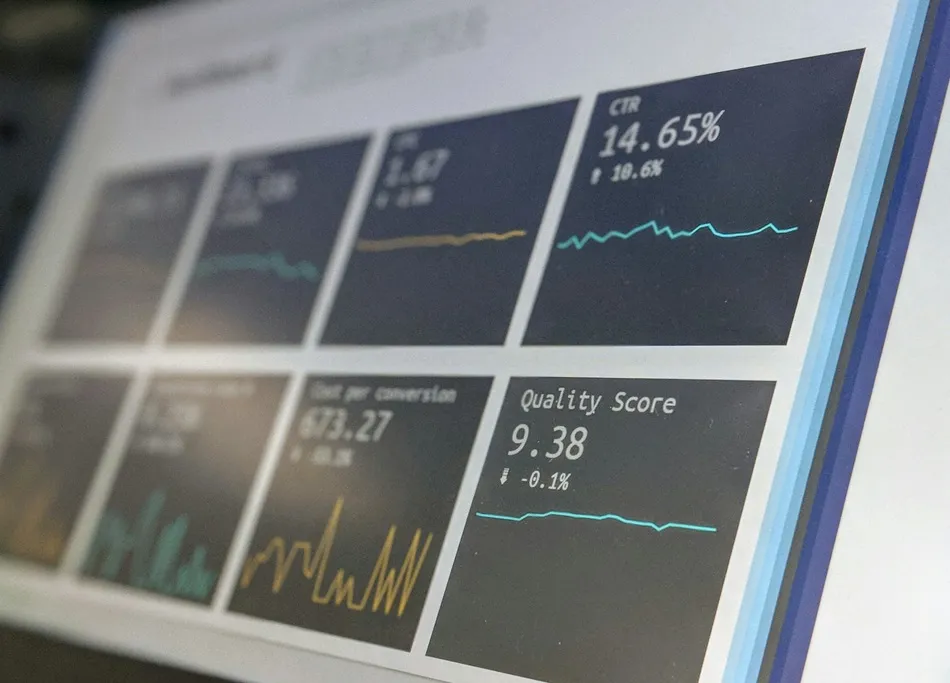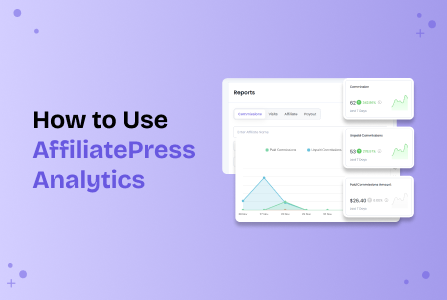What Is Affiliate Fraud And How To Prevent It (Guide)

- What is Affiliate Fraud?
- Common Affiliate Fraud and Risk Vectors
- How to Prevent Affiliate Fraud?
- 1. Choose software with built-in fraud protection
- 2. Enable fraud protection features
- 3. Review your commission and tracking rules
- 4. Use data analysis and stimulation environments
- Final Word: Run an Affiliate Program without Fraud
Affiliate marketing is vulnerable to many forms of fraud and manipulation, particularly in cookie-based tracking systems.
This means dishonest affiliates can trick the system by placing fake tracking cookies on a user’s device, so they get a commission for a sale that doesn’t belong to them.
Landing pages, transactions, conversion tracking, and other features of the affiliate network platform are prone to fraud when you are not prepared.
The emotional side of being exposed to affiliate fraud is probably the most important because it influences trust. You can lose trust in affiliate programs, and affiliates can lose reputation. And trust is a fuel for an affiliate program to work properly. What’s more, affiliate networks may even face legal risk if they don’t enforce fraud controls.
In this article, we want to look at ways to keep trust in your affiliate program and help you sleep without stress.
But let’s start with clarifying the basics.
What is Affiliate Fraud?

So, what is affiliate fraud? Who commits affiliate fraud?
Fraudulent affiliates are most common; they steal rightful commissions from your legitimate affiliates (e.g. they overwrite cookies or hijack traffic). They are looking to manipulate tracking systems, e.g. with cookie stuffing, to claim commissions they didn’t actually earn. Super rarely, affiliate fraud can be generated by low-quality affiliate networks that hide attribution or serve you opaque reporting.
Many frauds depend on business logic, software, and website security. For example, how cookies are managed, whether cookie overwriting is allowed, how commissions are shared, etc. – specific settings can trigger fraud.
For example, the last affiliate whose cookie is present before a purchase gets 100% of the commission. This is a scenario where a fraud incentive comes into play: an affiliate can use cookie-stuffing or load-time clicks to secretly overwrite existing cookies just before the purchase. A legitimate affiliate might have originally referred the buyer earlier, but the fraudster’s cookie becomes the “last one” and steals the commission.
In this case, consumers are also indirect victims of fraud. They are not directly financially harmed, but their browsing experience is degraded by hidden iframes, pop-ups, and redirects. This means their privacy is compromised by unauthorized tracking cookies.
Common Affiliate Fraud and Risk Vectors

We’ve just described a few examples of how affiliate fraud can actually happen. But you want to be better introduced to various ways of possible harmful activities inside your affiliate system, right?
- Cookie-stuffing: Where an affiliate inserts tracking cookies into a user’s browser without user consent, so that any purchase (even if through another channel or affiliate) grants commission to the fraudulent affiliate.
- Load-time click: It includes automatic click, non-user-initiated click. For example, via invisible iframes, image tags, or JavaScript triggered at page load rather than user click.
- Overwriting affiliate cookies: e.g. “last click” vs “share commission” models.
- Manipulations: Such as synthetic/false conversions, fake transaction IDs, mismatches between what the affiliate network claims vs what the advertiser records.
How to Prevent Affiliate Fraud?
Without affiliate fraud protection measures in place, your financial goals, affiliates’ trust, and buyers’ privacy are all at risk.
But the key thing is, fraud risks are not purely technical.
Your business rules (commission sharing, cookie overwriting, affiliate network policies) can significantly affect which frauds are possible or profitable. Let’s take a closer look.
1. Choose software with built-in fraud protection

For affiliate programs on WordPress sites, plugins offer various integrated tools to protect conversions and clicks from fraud. Those include bot filters, conversion rate analysis reports, Captcha insertion, and even more manual control over payouts.
But they can only partially handle common, simple fraud (self-referrals, repeated clicks, basic bots).
AffiliatePress, an affiliate plugin for WordPress, comes with smart fraud detection that actively scans your affiliate program for fake clicks, bot activity, and suspicious patterns. It doesn’t require keeping an eye on it all the time. It’s designed to stop fraud before you can even notice it.
2. Enable fraud protection features

Other platforms, tools, and software widely use anti-fraud layers like:
- IP address monitoring (detecting multiple conversions from the same IP).
- Multi-layer authentication (2FA, identity verification).
- Anomaly detection with third-party anti-fraud services.
- Advanced encryption (SSL/TLS, end-to-end).
- AI or machine learning fraud detection.
- CAPTCHA.
- Real-time transaction monitoring.
But that all should be combined with some level of manual control, especially in financial monitoring.
3. Review your commission and tracking rules

Mitigation of affiliate fraud risks must consider both technology and business policy.
This means the way you set up commission attribution rules in your affiliate program can even encourage fraud strategies, while another one doesn’t.
Take a look at your rules and analyze whether they open a window of opportunities for malicious activities.
For example, when it comes to cookie expiration, shorter windows are generally better for fraud protection, since they limit the time a fraudster has to claim credit from stolen or injected cookies, as well as reduce risk from long-term “cookie stuffing” attacks.
Or, if you don’t restrict attribution by location or device type, fraudsters can generate commissions from bots across regions or multiple devices.
4. Use data analysis and stimulation environments

For more advanced settings and custom ecosystems, it’s recommended to use a fraud simulation environment. The simulation environment can replicate multiple variants of cookie-stuffing and load-time click fraud to stress-test it for your affiliate program.
Use of multiple virtual machines, different domains, and cross-origin testing (e.g. iframes, etc.), to better replicate the kinds of cross-domain and cross-site restrictions or vulnerabilities that exist in real settings.
Final Word: Run an Affiliate Program without Fraud
Affiliate websites, where ads and tracking links are placed, can definitely stimulate fraudulent behaviours.
There are a few broad categories where you can take action:
- Protect your website domain.
- Enable automated fraud protection features in your affiliate software.
- Don’t neglect manual control for the most important actions, such as payouts and commission monitoring.
- Review your commission and cookie policies.
- Test and analyze.
To sum up the affiliate fraud risk protection, here are the steps you can think of:
- Test and detect fraud/risk scenarios.
- Use only trusted software with high fraud protection levels.
- Offer cookie expiration limits or IP restrictions to reduce “cookie stuffing” attacks.
- Choose providers with industry certifications (e.g., PCI DSS compliance for payments).
- Reduce cookie expiration window.
- Use AI for automated analysis and monitoring.
- Relies on manual control for things like payouts.
- Look for a solution that can filter “unimportant” signals.
- Look for a dedicated fraud response/support team.
And, hopefully, you can sleep better with these measures in place!
Related articles:





